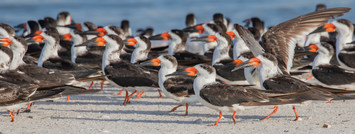
Celebrate Independence Day the Floridian Way
As people make plans for the Independence Day holiday, the FWC is reminding the public to help protect beach-nesting shorebirds by giving them space and keeping personal fireworks off the beach.
Shorebirds on Florida’s Atlantic and Gulf coasts are nesting now, with many of them watching over flightless chicks. Threatened species such as the snowy plover, least tern, black skimmer and American oystercatcher are among the shorebirds facing conservation challenges and needing help from people to survive. Loud noises can cause adults to flush off their nests and tiny chicks to become separated from parents, leaving them vulnerable to predators, the elements, and getting stepped on by beachgoers. At the beach or on a waterway, help shorebirds and seabirds be safe by remembering these tips for celebrating Independence Day the Floridian Way:
Attend an official fireworks display. The loud sounds and bright lights of personal fireworks on Florida's beaches and waterways can have catastrophic effects on nesting birds and their chicks, as well as nesting sea turtles. Help wildlife and people enjoy the beach by leaving personal fireworks at home.
Give shorebirds and seabirds the space to feel safe. In the summer, Florida beaches are a nursery for baby birds. The beach is also the place the birds rest and refuel in between long flights. Help young birds grow by staying outside of posted areas and by giving all birds the space to rest and eat.
Do the Flock Walk. To avoid predators, shorebirds and seabirds often flock together when resting, nesting, and eating. Continuous disturbance to a flock makes them vulnerable to predators and depletes energy reserves critical to their survival. Join your neighbors in recognizing a flock of shorebirds and seabirds and walking far around them. Repeat at the next flock.
Stash the trash. Picnic leftovers, fish scraps and trash attract predators that also eat eggs and young shorebirds and seabirds. Help keep predators at bay by not feeding birds and putting waste in a trash bin.
Use a leash when at the beach. Even good dogs and responsible people can frighten shorebirds and seabirds. Birds see all dogs as predators. If you're visiting a pet-friendly beach, keep your furry friend on a leash.
Enjoy a CWA by boating the Floridian way. Critical Wildlife Areas (CWAs) often support high concentrations of nesting birds. Boaters can help nesting birds by staying out of closed areas and not congregating near CWAs.
Practice disturbance-free photography. Florida’s wildlife photographers are shorebird-friendly. A novice or a pro, Florida wildlife photographers know how to be shorebird-friendly when getting the perfect shot.
Spread the word. Let your friends and family know how important it is to give shorebirds space and share the message on social media!
Report disturbance of nesting birds to the FWC’s Wildlife Alert Hotline at 888-404-FWCC (3922) or by texting Tip@MyFWC.com.
Have a happy Independence Day while sharing the shore!
Photo by Jean Hall
|